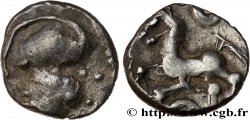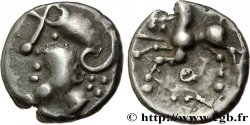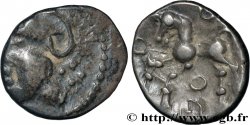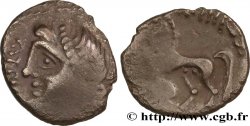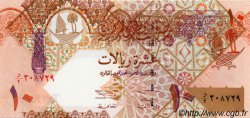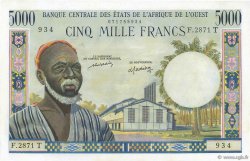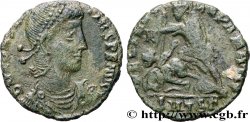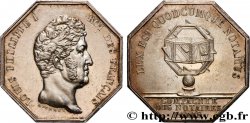v38_1535 - GALLIA - GALLIA DELLO SETTENTRIONALE - ÆDUI (BIBRACTE, Regione dello Mont-Beuvray) Quart de statère en électrum à la lyre, type de Chenôves
MONNAIES 38 (2009)
Начальная цена : 500.00 €
Назначить цену : 900.00 €
Цена реализации : 640.00 €
Количество ставок : 4
Максимальная предлагаемая цена : 820.00 €
Начальная цена : 500.00 €
Назначить цену : 900.00 €
Цена реализации : 640.00 €
Количество ставок : 4
Максимальная предлагаемая цена : 820.00 €
Тип Quart de statère en électrum à la lyre, type de Chenôves
Дата: c. 70-50 AC.
Монетный двор / Город: Autun (71)
Металл: electrum
Диаметр: 11 mm
Ориентация осей монеты: 7 h.
Вес: 1,45 g.
Редкость: R2
Комментарии о состоянии
Bel exemplaire pour cette exacte réduction modulaire du statère. Métal rouge, cuivreux, avec une très belle patine irisée et brillante, surtout au droit. Les types sont complets et bien centrés sur ce flan un peu court, avec un droit légèrement moins détaillé que le revers
Ссылки в каталоге: :
Происхождение:
Cette monnaie provient de la collection M. R. de Dijon
Лицевая сторона
Аверс: легенда: ANÉPIGRAPHE.
Аверс: описание: Tête humaine laurée à droite, la chevelure stylisée ; grènetis.
Обратная сторона
Реверс: легенда: ANÉPIGRAPHE.
Реверс: Описание: Cheval galopant à droite ; au-dessus du cheval, l'aurige ; lyre sous le cheval.
Комментарий
Ces monnaies du type de Chenôves se divisent en deux types ; à la lyre (classe I) ou à la rouelle (classe II). Le traitement de la chevelure correspond exactement à celle du statère DT. 3176 avec les mèches en forme de goutte et aux extrémités enroulées, ainsi qu’au denier à la lyre, DT. 3182 et 3183.
Sur cet exemplaire, le revers est un peu confus, comme si le flan avait été précédemment frappé mais de façon très décentrée puis refrappé (?).
These coins of the Chenôves type are divided into two types: lyre (class I) or wheel (class II). The treatment of the hair corresponds exactly to that of the stater DT. 3176 with the drop-shaped locks and rolled ends, as well as to the denarius with the lyre, DT. 3182 and 3183. On this example, the reverse is a little confused, as if the flan had been previously struck but very off-center and then re-struck (?)
Sur cet exemplaire, le revers est un peu confus, comme si le flan avait été précédemment frappé mais de façon très décentrée puis refrappé (?).
These coins of the Chenôves type are divided into two types: lyre (class I) or wheel (class II). The treatment of the hair corresponds exactly to that of the stater DT. 3176 with the drop-shaped locks and rolled ends, as well as to the denarius with the lyre, DT. 3182 and 3183. On this example, the reverse is a little confused, as if the flan had been previously struck but very off-center and then re-struck (?)








 Cообщить об ошибке
Cообщить об ошибке Распечатать страницу
Распечатать страницу Отправить мой выбор
Отправить мой выбор Задать вопрос
Задать вопрос Consign / sell
Consign / sell
 Информация
Информация